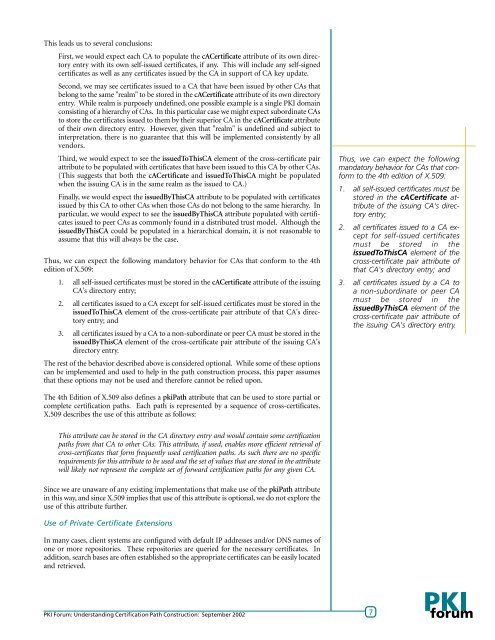Understanding Certification Path Construction - oasis pki
Understanding Certification Path Construction - oasis pki
Understanding Certification Path Construction - oasis pki
You also want an ePaper? Increase the reach of your titles
YUMPU automatically turns print PDFs into web optimized ePapers that Google loves.
This leads us to several conclusions:First, we would expect each CA to populate the cACertificate attribute of its own directoryentry with its own self-issued certificates, if any. This will include any self-signedcertificates as well as any certificates issued by the CA in support of CA key update.Second, we may see certificates issued to a CA that have been issued by other CAs thatbelong to the same "realm" to be stored in the cACertificate attribute of its own directoryentry. While realm is purposely undefined, one possible example is a single PKI domainconsisting of a hierarchy of CAs. In this particular case we might expect subordinate CAsto store the certificates issued to them by their superior CA in the cACertificate attributeof their own directory entry. However, given that "realm" is undefined and subject tointerpretation, there is no guarantee that this will be implemented consistently by allvendors.Third, we would expect to see the issuedToThisCA element of the cross-certificate pairattribute to be populated with certificates that have been issued to this CA by other CAs.(This suggests that both the cACertificate and issuedToThisCA might be populatedwhen the issuing CA is in the same realm as the issued to CA.)Finally, we would expect the issuedByThisCA attribute to be populated with certificatesissued by this CA to other CAs when those CAs do not belong to the same hierarchy. Inparticular, we would expect to see the issuedByThisCA attribute populated with certificatesissued to peer CAs as commonly found in a distributed trust model. Although theissuedByThisCA could be populated in a hierarchical domain, it is not reasonable toassume that this will always be the case.Thus, we can expect the following mandatory behavior for CAs that conform to the 4thedition of X.509:1. all self-issued certificates must be stored in the cACertificate attribute of the issuingCA's directory entry;2. all certificates issued to a CA except for self-issued certificates must be stored in theissuedToThisCA element of the cross-certificate pair attribute of that CA's directoryentry; and3. all certificates issued by a CA to a non-subordinate or peer CA must be stored in theissuedByThisCA element of the cross-certificate pair attribute of the issuing CA'sdirectory entry.The rest of the behavior described above is considered optional. While some of these optionscan be implemented and used to help in the path construction process, this paper assumesthat these options may not be used and therefore cannot be relied upon.Thus, we can expect the followingmandatory behavior for CAs that conformto the 4th edition of X.509:1. all self-issued certificates must bestored in the cACertificate attributeof the issuing CA's directoryentry;2. all certificates issued to a CA exceptfor self-issued certificatesmust be stored in theissuedToThisCA element of thecross-certificate pair attribute ofthat CA's directory entry; and3. all certificates issued by a CA toa non-subordinate or peer CAmust be stored in theissuedByThisCA element of thecross-certificate pair attribute ofthe issuing CA's directory entry.The 4th Edition of X.509 also defines a <strong>pki</strong><strong>Path</strong> attribute that can be used to store partial orcomplete certification paths. Each path is represented by a sequence of cross-certificates.X.509 describes the use of this attribute as follows:This attribute can be stored in the CA directory entry and would contain some certificationpaths from that CA to other CAs. This attribute, if used, enables more efficient retrieval ofcross-certificates that form frequently used certification paths. As such there are no specificrequirements for this attribute to be used and the set of values that are stored in the attributewill likely not represent the complete set of forward certification paths for any given CA.Since we are unaware of any existing implementations that make use of the <strong>pki</strong><strong>Path</strong> attributein this way, and since X.509 implies that use of this attribute is optional, we do not explore theuse of this attribute further.Use of Private Certificate ExtensionsIn many cases, client systems are configured with default IP addresses and/or DNS names ofone or more repositories. These repositories are queried for the necessary certificates. Inaddition, search bases are often established so the appropriate certificates can be easily locatedand retrieved.PKI Forum: <strong>Understanding</strong> <strong>Certification</strong> <strong>Path</strong> <strong>Construction</strong>: September 2002 7





